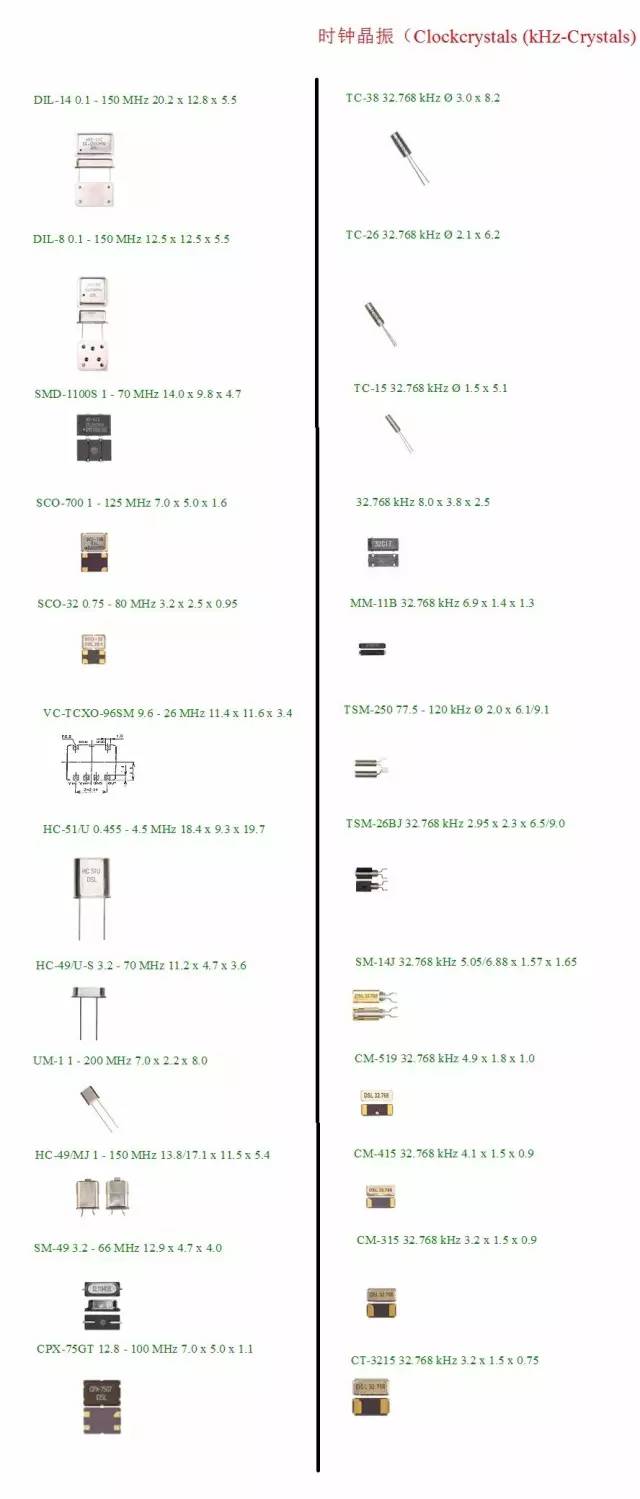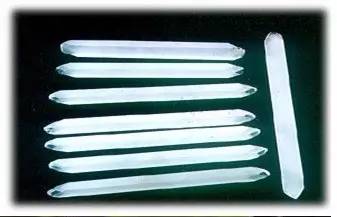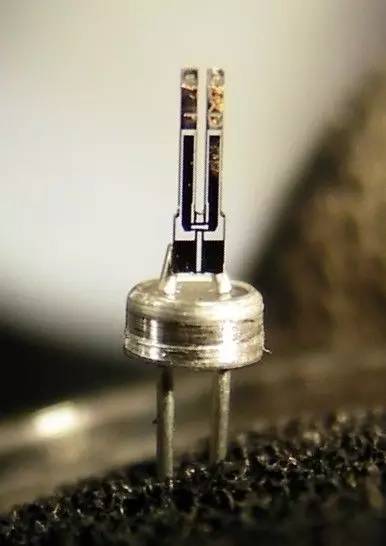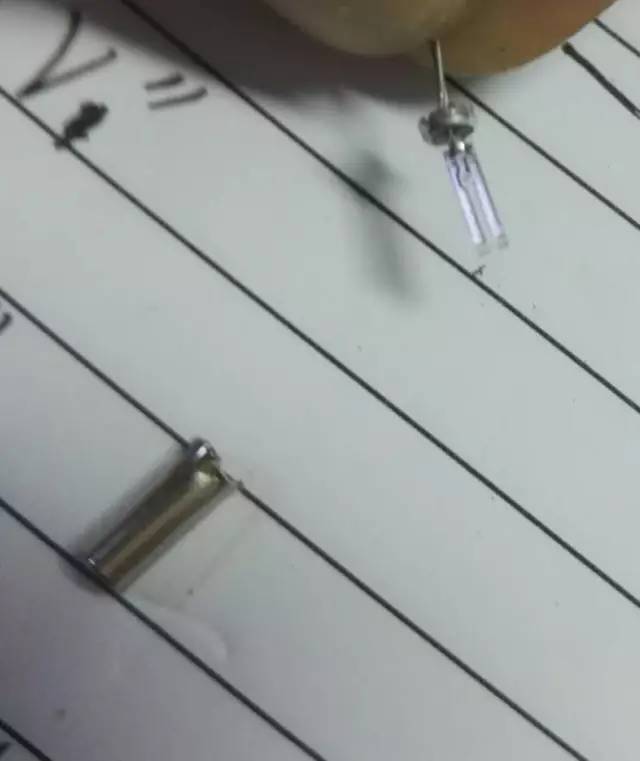Two young colleagues drew a circuit board because of the 32.768 kHz crystal that was previously selected for the FC135 package. So in order to put a 25MHz crystal, this package is also made. However, there is no communication with purchasers and suppliers.
When the circuit is cast, it is dumbfounded when preparing to purchase components. The 25MHz crystal oscillator in the FC135 package is not available at all. So the old comrades who debugged the circuit screamed.

Why are some crystals with a package frequency of only 32.768 kHz?
First, let's look at a long picture to compare:

We can see that the 32.768kHz crystal package has almost no intersection with other frequency packages.
So, have experienced friends discovered the law of two columns of crystal oscillators?
So why is there such a phenomenon? What is special about the 32.768kHz crystal?
1, the basic principle of crystal oscillator
The oscillator is an energy converter. The quartz resonator uses a quartz crystal resonator to determine the operating frequency. Compared with the LC resonant circuit, it has high standard and high quality factor, and has high frequency stability. Degree, after using high precision and frequency stabilization measures, the quartz crystal oscillator can achieve 10-4~10-11 stability.
The basic performance is mainly to oscillate, and it can be used to respond to a certain frequency, used for filtering, frequency selective network, etc. The quartz resonator is equivalent to the RLC oscillating circuit.
Quartz crystal, commonly known as crystal, is a hexagonal pyramidal crystal with a chemical composition of silicon dioxide (SiO2), which is relatively hard. It has three mutually perpendicular axes and anisotropy: the longitudinal Z axis is called the optical axis, the X axis that passes through the ridgeline of the hexagonal prism and is perpendicular to the Z axis is called the electric axis, and the Y axis that is perpendicular to the X axis and the Z axis. (Vertical to the facet) is called the mechanical axis.

When pressure is applied along the electric or mechanical axis of the quartz wafer, positive and negative charges are generated on the three sides of the electric axis of the wafer, and a voltage is generated, which is proportional to the shape generated by the applied force; if tension is applied, it is generated. Reverse voltage, this phenomenon is called positive effect.
When an electric field is applied along the direction of the electric axis of the quartz wafer, the wafer will be extended or compressed in the direction of the electric axis and the mechanical axis to be deformed. This phenomenon is called an inverse piezoelectric effect. Therefore, when an alternating voltage is applied to the three sides of the crystal, the wafer will mechanically vibrate with changes in voltage, and mechanical vibration will generate alternating charges on the inner surface of the wafer. Since the crystal is a resilient solid, there is an inherent mechanical resonant frequency for a certain mode of vibration. When the applied AC voltage is equal to the inherent mechanical resonance frequency of the wafer, the mechanical vibration amplitude of the wafer is the largest, and the current flowing through the wafer is the largest, resulting in a resonance phenomenon. The resonance of the quartz wafer has multi-harmonicity, that is, in addition to the fundamental frequency resonance, it can also resonate. Generally, a resonator using the fundamental resonance of the wafer and a resonator using the wafer harmonic resonance are called an overtone resonator. It is possible to use odd harmonics such as 3, 5, and 7. The vibration frequency of the wafer is inversely proportional to the thickness. The higher the operating frequency, the thinner the wafer (the larger the size, the lower the frequency) , the worse the mechanical strength of such a wafer, the more difficult it is to process, and the easier it is to shatter. Overtone crystals are often used when operating at higher frequencies. Generally, a fundamental frequency crystal is used when the operating frequency is less than 20 MHz, and an overtone crystal is used when the operating frequency is greater than 20 MHz.
The quartz crystal oscillator is a resonant device made by utilizing the piezoelectric effect of a quartz crystal (crystal of silicon dioxide), and its basic constitution is roughly: cutting a sheet from a quartz crystal at a certain azimuth angle (referred to as a wafer, It can be square, rectangular or circular, etc., with a silver layer applied as an electrode on its two corresponding faces, and a lead wire is attached to each pin on each electrode, and the package is formed. Quartz crystal resonator, referred to as quartz crystal or crystal, crystal. Its products are typically packaged in a metal case and are also available in glass, ceramic or plastic.


The main parameters of the crystal oscillator are nominal frequency, load capacitance, frequency accuracy, frequency stability and so on. Different crystals have different nominal frequencies, and the nominal frequencies are mostly indicated on the crystal case.
For example, the common crystal oscillator nominal frequency is: 48kHz, 500 kHz, 503.5 kHz, 1MHz ~ 40.50 MHz, etc. For special requirements, the crystal frequency can reach above 1000 MHz, and some have no nominal frequency, such as CRB, ZTB, Ja, etc. . The load capacitance refers to the sum of all the effective capacitances inside and outside the IC block connected to the two leads of the crystal oscillator. It can be regarded as the serial connection capacitor of the crystal oscillator in the circuit. The different load frequencies determine the oscillation frequency of the oscillator.
For crystal oscillators with the same nominal frequency, the load capacitances are not necessarily the same. Because the quartz crystal oscillator has two resonant frequencies, one is a low-loaded capacitive crystal with a series-oscillated crystal oscillator: the other is a high-loaded capacitive crystal with a parallel oscillating crystal. Therefore, when the crystal oscillators with the same nominal frequency are interchanged, the load capacitance must be required to be one and cannot be exchanged. Otherwise, the electrical equipment will not work properly. Frequency accuracy and frequency stability: Since the performance of ordinary crystal oscillators can basically meet the requirements of general electrical appliances, it is necessary to have certain frequency accuracy and frequency stability for high-end equipment. Frequency accuracy ranges from 10^(-4) orders to 10^(-10) orders of magnitude. Stability ranges from ±1 to ±100ppm. It is necessary to select a suitable crystal oscillator according to the specific equipment needs, such as a communication network, and a wireless data transmission system requires a quartz crystal oscillator with higher requirements. Therefore, the parameters of the crystal determine the quality and performance of the crystal. In practical applications, it is necessary to select an appropriate crystal oscillator according to specific requirements. Because the crystal oscillators of different performances have different prices, the higher the price, the more expensive the price is. Generally, the choice is as long as the requirements are met.
When the crystal oscillator does not oscillate, it can be regarded as a plate capacitor C0, which is related to the geometry of the crystal and the electrode area, and the value is between several PF and several tens of PF. The inertia of the mechanical vibration of the crystal oscillator is equivalent to the inductance L, generally between 10-3-102H. The elasticity of the wafer is equivalent to the capacitance C1, the specific value of L and C and the cutting method, the size and shape of the wafer and the electrode. And so on.
Nominal frequency (FL), load capacitance (CL), frequency accuracy, frequency stability, etc.
Crystal quality, cutting orientation, crystal oscillator structure and circuit form, etc., together determine the performance of the oscillator
Fs: the inherent frequency of the crystal itself, and the way the crystal is cut, the thickness of the crystal, and the equivalent thickness of the crystal electrode.
F=2560/t(BT) F=1670/t(AT)
 2, tuning fork structure
2, tuning fork structure
 And Apple's cooperation, is the number zero devices manufacturers competing goals. Phone zero devices, crystal and SAW filter, 32.768K crystal form is an integral part of .iPhone 5 in 5 models quartz crystal, among them Two tuning fork crystals . Usually we think that 32.768K crystal can only be applied to some low-end electronic products . In fact, this is a mistake . Most electronic products involved in data processing require crystal oscillators to provide clock frequency. Otherwise, it will not start or work effectively . It can be seen that the crystal oscillator, especially the tuning fork crystal oscillator, is an important component in electronic products.
And Apple's cooperation, is the number zero devices manufacturers competing goals. Phone zero devices, crystal and SAW filter, 32.768K crystal form is an integral part of .iPhone 5 in 5 models quartz crystal, among them Two tuning fork crystals . Usually we think that 32.768K crystal can only be applied to some low-end electronic products . In fact, this is a mistake . Most electronic products involved in data processing require crystal oscillators to provide clock frequency. Otherwise, it will not start or work effectively . It can be seen that the crystal oscillator, especially the tuning fork crystal oscillator, is an important component in electronic products.

3. The frequency range of the no-slice mode is unreasonable.
Wafer cutting:
The most important component of the crystal oscillator is the crystal vibrator, which is cut by crystal crystal according to certain rules, also known as wafer.
There are three types of commonly used wafers: round, square, and SMT (square, but smaller)

The wafer can be cut into AT-CUT, BT-CUT, CT-CUT, DT-CUT, FT-CUT, XT-CUT, YT-CUT, as shown in Figure 7. It is based on the optical axis (Z-axis). Named by reference, each cut corresponds to an angle. Which cut method should be determined according to the actual situation. If the temperature characteristics are better, AT-CUT should be used. If the frequency required for crystal is higher, BT is used. -CUT. The cutting mode, geometry, size, etc. of the wafer determine the frequency of the crystal.
| Slice method | Frequency Range | mode | angle |
| AC | 31° | ||
| AK | Thickness | ||
| AT | 0.5–300 MHz | Thickness shear (c-mode, slow quasi-shear) | 35°15', 0° (<25 MHz) 35°18', 0° (>10 MHz) |
| BC | −60° | ||
| BT | 0.5–200 MHz | Thickness shear (b-mode, fast quasi-shear) | −49°8', 0° |
| CT | 300–900 kHz | Face shear | 38°, 0° |
| DT | 75–800 kHz | Face shear | −52°, 0° |
| E , 5°X | 50–250 kHz | Longitudal | |
| ET | 66°30' | ||
| FC | Thickness | ||
| FT | −57° | ||
| GT | 0.1–3 MHz | Width-extensional | 51°7' |
| H | 8–130 kHz | Length-width flexure | |
| IT | Thickness | ||
| J | 1–12 kHz | Length-thickness flexure | |
| LC | Thickness | 11.17°/9.39° | |
| MT | 40–200 kHz | Longitudal | |
| NLSC | |||
| NT | 8–130 kHz | Length-width flexure (bending) | |
| RT | |||
| SBTC | |||
| SC | 0.5–200 MHz | Thickness | 35°15', 21°54' |
| SL | Face-shear | −57°, 0° | |
| TS | |||
| X | |||
| XY , tuning fork | 3–85 kHz | Length-width flexure | |
| X 30° | |||
| Y |
4, the tuning fork structure and other crystal oscillator size comparison
This is my actual disassembly of the 32.768kHz crystal, take pictures, show you the tuning fork structure.



Therefore, the frequency of crystals used in high-speed chips such as MCUs and CPUs is above 1MHz, which is why the main crystal package is generally different from the 32.768kHz package.
The tuning fork structure has been widely used, and if the internal structure is a tuning fork, the outer casing is often the shape of Yao Ming, which is slim and long. The cutting mode of the high-frequency crystal cannot be the tuning fork structure.
I am not a crystal cutting manufacturer, but through logic reasoning and analysis, using detective methods to explore the reasons for packaging differences. There are mistakes, hope masters and manufacturers correct me.
At the same time, remind the engineers, do not take it for granted, choose the crystal package, it is best to confirm before design.
Guangzhou Bolei Electronic Technology Co., Ltd. , https://www.nzpal.com